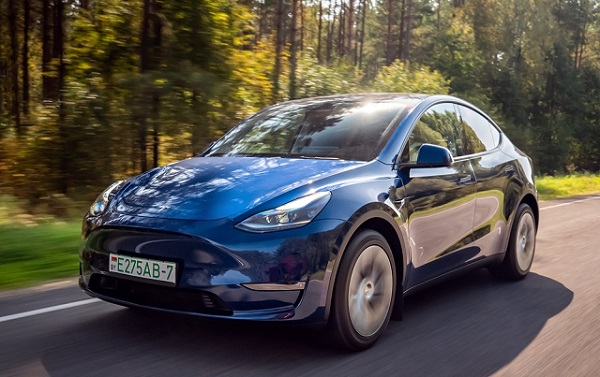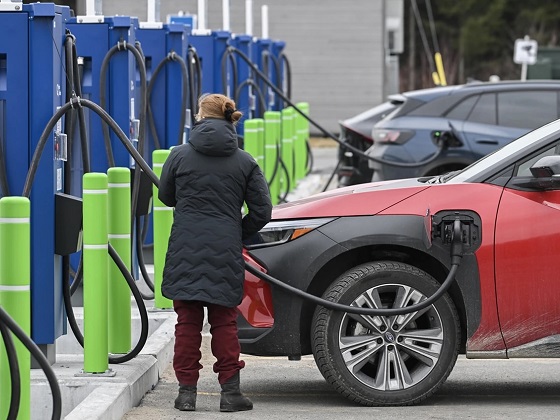Automotive
Electric vehicle weight poses threat to current road infrastructure, safety experts warn

Tesla Model Y
From LifeSiteNews
By Bob Unruh
A report in the Washington Times explains that electric vehicles (EVs) can weigh up to 50 percent more than internal combustion motor vehicles. That extra weight could more easily damage roads, bridges, and parking garages.
If all of the existing headaches for those pushing expensive electric vehicles on resisting American consumers could vanish, there’s still a big one that may have no ready solution.
Already, it appears the U.S. could end up dependent on unfriendly nations for materials for all those batteries. Then there’s the fact that the nation’s grid simply can’t support all that recharging – California already has been sending out advisories for owners not to charge. And then there’s the limited range, extended recharging times, both worsened by bad weather.
But now a report in the Washington Times explains that those batteries are heavy, and EVs can weigh up to 50 percent more than internal combustion motor vehicles.
And that weight damages roads, bridges and parking garages, with those vehicles easily plowing through safety guardrails while posing a higher danger to other drivers, pedestrians and bicyclists traveling the same routes.
“The problems associated with EVs are poised to grow as more consumers purchase the cars under the Biden administration’s plan to eliminate gas-powered vehicles and the tailpipe emissions that come with them,” the report explained.
It explained engineers writing recently for Structure Magazine suggested construction companies, and building codes, need to make accommodation for the higher weight.
Parking garages, they said, should be redesigned to hold more weight.
That’s because some hold hundreds of vehicles, and just one EV. A Ford truck, weighs in at 8,240 pounds, nearly a ton (about 1,000 kg) more than the gas-powered version of the same pickup.
“Significantly increasing passenger vehicle weights combined with recently reduced structural design requirements will result in reduced factors of safety and increased maintenance and repair costs for parking structures,” the engineers wrote. “There are many cases of parking structure failures, and the growing demand for EVs will only increase the probability of failure.”
Then there are those guardrails, installed to minimize damage when traffic goes awry.
They are installed between lanes for traffic moving opposite directions, between lanes and edge drop-offs and more.
That concern comes out of a procedure at a test facility in Nebraska, where examiners took a 3.6-ton Rivian R1 and sent it into a metal guardrail at 62 mph, first head-on, then at an angle.
Both times it “ripped through” the guardrail and continued into what would have been lanes for oncoming traffic, the report revealed.
The conclusion was simple: making vehicles much heavier means “a lot more force” is required to redirect the vehicle.
University of Nebraska professor Cody Stolle, told the Times, “We found these guardrail systems don’t have great compatibility with these [electric] vehicles yet.”
The heavier vehicles also could cause more damage to other vehicles in collisions.
The report said an insurance institute expert confirmed the weight provides more protection to those inside the EV, but at the expense of anyone in another vehicle involved in an accident.
Joe Biden has insisted over and over that consumers should be buying the much more expensive and often less reliable electric cars the government programs subsidize.
The weight differences are significant. The report said the Tesla Model Y is more than 4,400 pounds while the similar size gas-powered Honda Accord is 3,300. Kia makes multiple SUVs, with the gas model weighting 3,900 pounds and the EV unit nearly 6,500.
Residential roads already are not engineered to handle the heavy weight on highways, and the lifespan of bridges could be reduced with much heavier traffic, the report said.
Sen. Marco Rubio, R-Fla., recently said, “EVs are typically much heavier compared to similarly sized, gas-powered vehicles, which will put additional strain on America’s transportation infrastructure. The American Society of Civil Engineers warns that an increase in EVs could substantially reduce the lifespan of roads and bridges, necessitating further investment in infrastructure.”
Reprinted with permission from the WND News Center.
Automotive
Power Struggle: Governments start quietly backing away from EV mandates

From Resource Works
Barry Penner doesn’t posture – he brings evidence. And lately, the evidence has been catching up fast to what he’s been saying for months.
Penner, chair of the Energy Futures Institute and a former B.C. environment minister and attorney-general, walked me through polling that showed a decisive pattern: declining support for electric-vehicle mandates, rising opposition, and growing intensity among those pushing back.
That was before the political landscape started shifting beneath our feet.
In the weeks since our conversation, the B.C. government has begun retreating from its hardline EV stance, softening requirements and signalling more flexibility. At the same time, Ottawa has opened the door to revising its own rules, acknowledging what the market and motorists have been signalling for some time.
Penner didn’t need insider whispers to see this coming. He had the data.

Barry Penner, Chair of the Energy Futures Institute
B.C.’s mandate remains the most aggressive in North America: 26 per cent ZEV sales by 2026, 90 per cent by 2030, and 100 per cent by 2035. Yet recent sales paint a different picture. Only 13 per cent of new vehicles sold in June were electric. “Which means 87 per cent weren’t,” Penner notes. “People had the option. And 87 per cent chose a non-electric.”
Meanwhile, Quebec has already adjusted its mandate to give partial credit for hybrids. Polling shows 76 per cent of British Columbians want the same. The trouble? “There’s a long waiting list to get one,” Penner says.
Cost, charging access and range remain the top barriers for consumers. And with rebates shrinking or disappearing altogether, the gap between policy ambition and practical reality is now impossible for governments to ignore.
Penner’s advice is simple, and increasingly unavoidable: “Recognition of reality is in order.”
- Now watch Barry Penner’s full video interview with Stewart Muir on Power Struggle here:
Automotive
The high price of green virtue

By Jerome Gessaroli for Inside Policy
Reducing transportation emissions is a worthy goal, but policy must be guided by evidence, not ideology.
In the next few years, the average new vehicle in British Columbia could reach $80,000, not because of inflation, but largely because of provincial and federal climate policy. By forcing zero-emission-vehicle (ZEV) targets faster than the market can afford, both governments risk turning climate ambition into an affordability crisis.
EVs are part of the solution, but mandates that outpace market acceptance risk creating real-world challenges, ranging from cold-weather travel to sparse rural charging to the cost and inconvenience for drivers without home charging. As Victoria and Ottawa review their ZEV policies, the goal is to match ambition with evidence.
Introduced in 2019, BC’s mandate was meant to accelerate electrification and cut emissions from light-duty vehicles. In 2023, however, it became far more stringent, setting the most aggressive ZEV targets in North America. What began as a plan to boost ZEV adoption has now become policy orthodoxy. By 2030, automakers must ensure that 90 per cent of new light-duty vehicles sold in BC are zero-emission, regardless of what consumers want or can afford. The evidence suggests this approach is out of step with market realities.
The province isn’t alone in pursuing EV mandates, but its pace is unmatched. British Columbia, Quebec, and the federal government are the only ones in Canada with such rules. BC’s targets rise much faster than California’s, the jurisdiction that usually sets the bar on green-vehicle policy, though all have the same goal of making every new vehicle zero-emission by 2035.
According to Canadian Black Book, 2025 model EVs are about $17,800 more expensive than gas-powered vehicles. However, ever since Ottawa and BC removed EV purchase incentives, sales have fallen and have not yet recovered. Actual demand in BC sits near 16 per cent of new vehicle sales, well below the 26 per cent mandate for 2026. To close that gap, automakers may have to pay steep penalties or cut back on gas-vehicle sales to meet government goals.
The mandate also allows domestic automakers to meet their targets by purchasing credits from companies, such as Tesla, which hold surplus credits, transferring millions of dollars out of the country simply to comply with provincial rules. But even that workaround is not sustainable. As both federal and provincial mandates tighten, credit supplies will shrink and costs will rise, leaving automakers more likely to limit gas-vehicle sales.
It may be climate policy in intent, but in reality, it acts like a luxury tax on mobility. Higher new-vehicle prices are pushing consumers toward used cars, inflating second-hand prices, and keeping older, higher-emitting vehicles on the road longer. Lower-income and rural households are hit hardest, a perverse outcome for a policy meant to reduce emissions.
Infrastructure is another obstacle. Charging-station expansion and grid upgrades remain far behind what is needed to support mass electrification. Estimates suggest powering BC’s future EV fleet alone could require the electricity output of almost two additional Site C dams by 2040. In rural and northern regions, where distances are long and winters are harsh, drivers are understandably reluctant to switch. Beyond infrastructure, changing market and policy conditions now pose additional risks to Canada’s EV goals.
Major automakers have delayed or cancelled new EV models and battery-plant investments. The United States has scaled back or reversed federal and state EV targets and reoriented subsidies toward domestic manufacturing. These shifts are likely to slow EV model availability and investment across North America, pushing both British Columbia and Ottawa to reconsider how realistic their own targets are in more challenging market conditions.
Meanwhile, many Canadians are feeling the strain of record living costs. Recent polling by Abacus Data and Ipsos shows that most Canadians view rising living costs as the country’s most pressing challenge, with many saying the situation is worsening. In that climate, pressing ahead with aggressive mandates despite affordability concerns appears driven more by green ideology than by evidence. Consumers are not rejecting EVs. They are rejecting unrealistic timelines and unaffordable expectations.
Reducing transportation emissions is a worthy goal, but policy must be guided by evidence, not ideology. When targets become detached from real-world conditions, ideology replaces judgment. Pushing too hard risks backlash that can undo the very progress we are trying to achieve.
Neither British Columbia nor the federal government needs to abandon its clean-transportation objectives, but both need to adjust them. That means setting targets that match realistic adoption rates, as EVs become more affordable and capable, and allowing more flexible compliance based on emissions reductions rather than vehicle type. In simple terms, the goal should be cutting emissions, not forcing people to buy a specific type of car. These steps would align ambition with reality and ensure that environmental progress strengthens, rather than undermines, public trust.
With both Ottawa and Victoria reviewing their EV mandates, their next moves will show whether Canadian climate policy is driven by evidence or by ideology. Adjusting targets to reflect real-world affordability and adoption rates would signal pragmatism and strengthen public trust in the country’s clean-energy transition.
Jerome Gessaroli is a senior fellow at the Macdonald-Laurier Institute and leads the Sound Economic Policy Project at the BC Institute of British Columbia
-

 National2 hours ago
National2 hours agoMedia bound to pay the price for selling their freedom to (selectively) offend
-

 Bruce Dowbiggin1 hour ago
Bruce Dowbiggin1 hour agoSometimes An Ingrate Nation Pt. 2: The Great One Makes His Choice
-

 International2 days ago
International2 days agoFBI may have finally nabbed the Jan. 6 pipe bomber
-

 Bruce Dowbiggin2 days ago
Bruce Dowbiggin2 days agoIntegration Or Indignation: Whose Strategy Worked Best Against Trump?
-

 MAiD2 days ago
MAiD2 days ago101-year-old woman chooses assisted suicide — press treats her death as a social good
-

 COVID-191 day ago
COVID-191 day agoUniversity of Colorado will pay $10 million to staff, students for trying to force them to take COVID shots
-

 Business2 days ago
Business2 days agoCarney’s Toronto cabinet meetings cost $530,000
-

 espionage2 days ago
espionage2 days agoDigital messages reportedly allege Chinese police targeted dissident who died suspiciously near Vancouver






